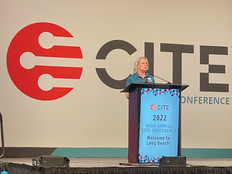How To II
Kentucky’s Individual Learning Plan
Students get a new focus on their postsecondary studies and careers.
This school year, middle and high school students in Kentucky public schools have a new online education-planning tool at their fingertips. The Web-enabled Individual Learning Plan (ILP) will help students in grades six through 12 better focus their coursework on individual goals as they prepare for postsecondary studies and careers.
Until this year, Kentucky schools have used the paper-based Individual Graduation Plan (IGP) for students in grades eight through 12. This program was designed to provide a map for students as they moved through high school and to help them plan for each grade and for postsecondary work. In an effort to make the IGP more meaningful to the student and accessible to all those interested in the student’s education, the district began to turn the IGP into a Web-enabled ILP beginning with students in the sixth grade.
Setting Up the New Plan
An ILP research team gathered key components, specific needs and desired outcomes to create a request for proposals for the new plan. The Kentucky Department of Education consulted school districts, teachers, parents and staff within the department to ensure that the new plan would help all these groups.
After an ILP selection committee completed an extensive evaluation of products, the Department of Education awarded the contract to a Canadian firm that created a plan specifically to meet the needs of the state’s students. The new plan affects about 350,000 students; the contract costs the state $365,000 per year. The service is free to schools. The ILP, which contains the same information that students gathered with the IGP, will eventually replace the paper document.
Getting Started
While this project is no different from any other systemwide effort that involves IT expertise, here are three tips that can help you start:
- Involve IT staff from the start
- Create a plan of action
- Modify existing protocols, if needed, to include the project’s work
The ILP offers more opportunities for schools, teachers, advisors and parents to help students optimize their secondary educational experience. The ILP is required of schools through a state regulation. That regulation, which outlines high school graduation requirements, notes that each plan should be reviewed and approved at least once a year by students, parents and school officials.
The Kentucky Commissioner of Education introduced the ILP and asked all school districts to develop teams for its implementation. Installing such a large-scale tool required Career Cruising and the department to set up regional training sites where teams from schools and/or districts were trained in the use of the ILP. Those teams were equipped to return to their schools and train other staff members who will use the ILP. District and school planning was encouraged so that the ILP process was embedded in the school culture.
Because Kentucky’s education technology system is so well-ingrained in its public schools, the switch from the paper IGP to the electronic ILP is moving smoothly. Regional training sessions have allowed school districts to share information with their IT staffs quickly and efficiently.
The impact on districts’ IT staff has been fairly minimal, and the Department of Education’s support network for IT provides immediate help whenever it’s needed. That’s the key to success — IT support that is ongoing and embedded.
New Features
Since the ILP is Web-enabled, it will provide more tools and opportunities for the student than the IGP could. Depending on their level, students will be able to:
- begin career exploration in the sixth grade
- create education plans
- establish personal goals and revisit these as they progress through school
- create, maintain and update resumes
- track and reflect on their community-service experiences, work experiences, career-planning activities and extracurricular and organization activities
- explore colleges and postsecondary opportunities that match their career and life goals
- collect personal information such as assessment results, advising activities, demographic information and educational history
The ILP will play a key role in the advising component of a student’s education: Students will be able to receive advice and guidance specific to their ILP’s educational goals. The new tool will allow students to upload documents they think are representative of their educational experiences and levels.
The ILP Web site is available 24x7 from any Internet-connected computer. Parents can log in to help their children with the planning process. Students will have the ability, with parental permission, to invite college admissions counselors, potential employers or others to view their ILPs online.
Better Advisors
Teachers can use this tool to get to know their students better. As advisors, teachers will have the opportunity to record what topics were discussed with students, plus make notes and reflections that should enable more precise advising activities. Teachers can quickly gain access to information that will better inform them about the students’ interests and where they need more attention or advice.
The ILP will help parents and teachers provide every graduate with a plan for moving to the next level of learning and preparing to perform well in a chosen career. The ILP will give new relevance to what students learn in the classroom and connect them more to the world that awaits them.
New students’ ILPs are created automatically. Statewide unique student identifiers are used to link information from a number of sources, including demographic information and assessment results.
Since the ILP is keyed to a student’s unique identifier, the same plan will be continued from year to year as the student moves from middle to high school or changes school districts. ILPs will be maintained for five years after high school graduation, so that students can use them for other purposes. Ultimately, it may be possible to move the ILP with the student to Kentucky colleges and universities.
Schools, districts, teachers, students and parents have responded enthusiastically to the new plan. Students are thrilled to have so much career information in one place. Teachers and administrators have more possibilities when the ILP is used to its fullest potential. Administrators continue to see the connections it can make throughout the school, from scheduling to helping students apply to college.
Kentucky by the Numbers
- 175 school districts
- 1,249 schools
- 664,606 public school students
- $43,275 average teacher salary
- $7,914 per pupil expenditure
- 15-1 ratio of students to modern, high-performance computers (goal is 6-1)
- 2.6-1 ratio of teachers to modern, high-performance computers (goal is 1-1)
- 65.8% of Kentucky schools made AYP in 2005–06
- 56 schools failed to make AYP for four consecutive years
- 26 schools failed to make AYP for three consecutive years







